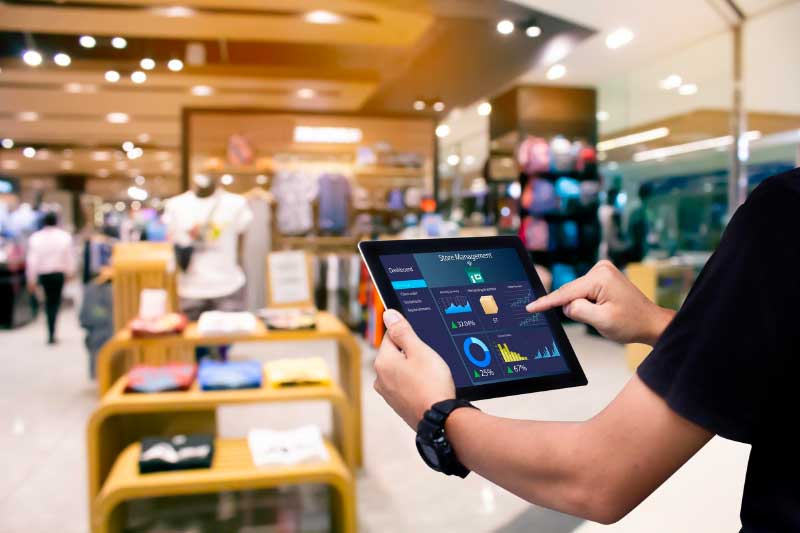
Apparel management software in 2023 is expected to evolve and become more sophisticated, providing apparel companies with advanced features and capabilities to manage their operations more efficiently and effectively.
Here are some potential trends and features we might see in apparel management software in 2023:
Artificial intelligence (AI) and machine learning (ML): Apparel management software will likely incorporate more AI and ML capabilities to help companies automate and streamline their operations. For example, AI and ML can optimize production schedules, forecast demand, and analyze sales data to identify trends and opportunities.
Cloud-based solutions: Cloud-based solutions are becoming increasingly popular in the apparel industry as they offer greater flexibility, scalability, and accessibility. Cloud-based apparel management software allows companies to access their data and applications from anywhere and on any device, making it easier to manage their operations remotely.
Integration with e-commerce platforms: As e-commerce grows, apparel management software will likely become more integrated with e-commerce platforms such as Shopify, Amazon, and Magento. This will allow companies to manage their inventory, sales, and shipments across multiple channels from a single platform. One company demonstrates how they can help with integration with e-commerce platforms here: https://www.apparelbusiness.com/apparel-management-software
Sustainability tracking: Apparel management software will likely include more features, allowing companies to track and report on their sustainability efforts. This can include tracking the environmental impact of their operations, monitoring their use of sustainable materials, and reporting on their social responsibility initiatives.
Virtual reality (VR) and augmented reality (AR): Apparel management software may also incorporate more VR and AR capabilities, allowing companies to create virtual showrooms and try-on experiences for customers. This can help improve the customer experience and increase sales.
What Are Some Existing Apparel Management Software in the Market?
Here are some examples of apparel management software that incorporate some of the features I mentioned:
BlueCherry is an apparel management software that offers advanced features such as PLM (Product Lifecycle Management), ERP (Enterprise Resource Planning), and WMS (Warehouse Management System). It also incorporates AI and machine learning capabilities to help companies enhance their operations and improve efficiency.
Fishbowl is a cloud-based inventory management software that incorporates with popular e-commerce platforms such as Shopify, Amazon, and Magento. It also offers advanced features such as barcode scanning, order management, and manufacturing management.
Gerber Technology is an apparel management software that offers a variety of features such as product design, pattern making, and production planning. It also incorporates AR and VR capabilities to help companies create virtual showrooms and enhance the customer experience.
FastReact is an apparel management software offering planning, forecasting, and production management features. It also incorporates sustainability tracking features to help companies monitor their environmental impact and social responsibility initiatives.
ApparelMagic is a comprehensive apparel management software with PLM, ERP, and inventory management features.
Which Factors Are Used To Evaluate Specific Needs And Requirements Of Apparel Businesses?
Here are some factors to consider when evaluating your specific needs and requirements for apparel management software:
Type of apparel business: Your apparel business will impact the type of software you need. For example, a small boutique may have different needs than a large manufacturing company.
Size of the business: The size of your business will also impact the type of software you need. A smaller business may not need as many features as a larger business and may benefit from a simpler, more affordable solution.
Business goals: Your goals should also be considered when evaluating apparel management software. If you want to expand your business, for example, you may need software that can handle larger volumes of orders and inventory.
Budget: Your budget will also be an important factor to consider. Some software solutions may be more expensive than others, and you should choose a solution that aligns with your budget.
Features and capabilities: When evaluating apparel management software, consider the features and capabilities you need. This may include inventory management, order management, production planning, or sustainability tracking.
Integration with other systems: You should also consider whether the software integrates with other systems you use, such as accounting software or e-commerce platforms.
Ease of use: Finally, you should consider the software’s ease of use. You want a solution that is user-friendly and easy to navigate, with a short learning curve for your employees.
Why Is Supply Chain Management Important for Apparel Businesses?
Supply chain management is important for apparel businesses for several reasons:
Timely production and delivery: A well-managed supply chain ensures that materials are available and products are manufactured and delivered on time. This is critical for apparel businesses to meet customer demand and maintain a competitive edge.
Cost management: Effective supply chain management can help apparel businesses control costs by optimizing production processes, reducing waste, and negotiating better prices with suppliers.
Quality control: A well-managed supply chain can help ensure consistent quality from suppliers and throughout production. This helps apparel businesses maintain their brand reputation and customer satisfaction.
Sustainability: Supply chain management can help apparel businesses implement sustainable practices by sourcing materials and products from suppliers who adhere to ethical and environmental standards.
Risk management: A well-managed supply chain can help apparel businesses mitigate risks such as supplier disruptions, natural disasters, and political instability. This helps ensure continuity of operations and minimizes the impact of unexpected events.
Collaboration and communication: Supply chain management involves collaboration and communication between suppliers, manufacturers, and retailers. This helps ensure that everyone is working together towards common goals and objectives.
Improved inventory management: Supply chain management software can help you optimize your inventory levels by tracking inventory in real time, identifying slow-moving items, and generating demand forecasts. This can help you avoid overstocking and reduce inventory holding costs.
Streamlined production processes: Supply chain management software can help you streamline your processes by identifying bottlenecks, optimizing production schedules, and improving resource allocation. This can help you reduce production costs and improve efficiency.
Reduced logistics costs: Supply chain management software can help you optimize transportation and logistics operations by identifying the most cost-effective routes, consolidating shipments, and reducing transportation lead times. This can help you reduce transportation costs and improve delivery times.
Improved supplier management: Supply chain management software can help you manage your suppliers more effectively by tracking supplier performance, identifying potential issues, and negotiating better terms. This can help you reduce procurement costs and improve supplier relationships.
Enhanced visibility and control: Supply chain management software provides real-time visibility into your operations, allowing you to identify issues and make informed decisions quickly. This can help you reduce costs associated with supply chain disruptions and delays.



